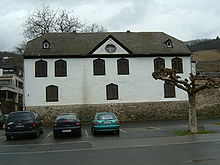Fronhof


As Fronhof the stately is farm called that in the center of a Villikation , so a unit within a medieval form of feudalism , stands. The word is derived from the Old High German frô "Herr". In Latin sources, the Fronhof is usually referred to as villa or curtis dominica , in German there are also names such as Salhof and Sedelhof .
The Fronhof was the economic and manorial center within the framework of a court association (villication); it was managed by the master himself or a court manager, the so-called Meier . The farmers imputed Fronhof the hooves paid this on one hand the fundamental interest and other charges and contributed the other hand, on the Fronhof the Frondienste .
A Fronhof was equipped with more or less extensive lands, which were operated by the landlord or his administrator on his own , and the entirety of which is referred to as Salland (terra salica) . For this purpose, both the labor of the farm servants and the labor of the hoof farmers were used. The latter could extend to several days a week. The duty of the hoof farmers, who also had to manage their own farms, was therefore considerable towards the Fronhof. The Fronhof itself comprised the residential buildings of the landlord or the Meier, as well as the servants and day laborers . This included the farm buildings (such as storehouses and barns). The Salland, which belongs to the Fronhof, was often made up of free float, depending on how land was added to the Fronhof through debt bondage or other circumstances. Fronhöfe usually had no contiguous area.
The Fronhof was not only the economic center of a villication, but also the center of the exercise of power. In particular, it was the site of the manorial court , which all hearing were subordinate members of Hofverbandes.
Large manors , especially those of kings and churches, sometimes formed entire networks of court associations, with several Fronhöfe being subordinate to one Oberhof.
The fronhof constitution, also known as the villication constitution, spread in the Franconian Empire from the 7th century and shaped the manorial constitution of early medieval rural society in Western and Central Europe. Since the 12th and 13th centuries, the increasing abandonment of the landlords' own economy in favor of a rented manor led to a loss of importance of the Fronhof within the rural settlement (for more details see the article Villication).
Since 2012 an archaeological reconstruction has been used in the Lauresham open-air laboratory (as part of the Lorsch Monastery, a UNESCO World Heritage Site ) to illustrate what a vestry yard in southern Germany could have looked like in Carolingian times .
literature
- Georg Ludwig von Maurer : History of the Fronhöfe, the farms and the court constitution in Germany. 4 volumes. Enke, Erlangen 1862–1863 (reprint: Aalen, Scientia 1961).
- Werner Rösener : Fronhof . In: Lexicon of the Middle Ages . 8 vol., Stuttgart (1977) -1999, vol. 4, col. 989 f.
Web links
- Sebastian Grüninger: Fronhof. In: Historical Lexicon of Switzerland .
Individual evidence
- ^ Wilhelm Volkert : Fronhof . In: Ders .: nobility to guild. A lexicon of the Middle Ages . CH Beck, Munich 1991, ISBN 3-406-35499-8 , p. 67.
- ↑ http://www.kloster-lorsch.de/lauresham0/allgemeineinformationen/